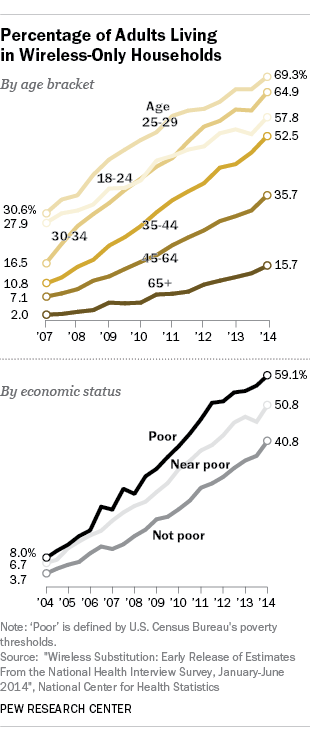The number of Americans who rely only on a cellphone for their telephone service continues to grow. Fully 43% of U.S. adults live in a household with a cellphone and no landline phone, according to new government data for the first half of 2014. That’s up four percentage points from just six months earlier. According to an extrapolation by Pew Research Center, an estimated 46.5% of adults are cell-only today.
To keep pace with this rapid trend, the Pew Research Center will increase the percentage of respondents interviewed on cellphones in its typical national telephone surveys to 65%; 35% of interviews will be conducted by landline. Last year, we increased the ratio to 60% cellphone, with 40% conducted on landline. Back in 2008, when we first started routinely including cellphones in our phone surveys, just one-fourth (25%) of all interviews were done by cellphone.

Our goal in making this change is to ensure that all adults are adequately represented in Pew Research Center surveys. Although cellphone-only households are very common today, there are sizeable demographic differences between people living in cell-only households and those with landlines.
For example, young adults, Hispanics, renters and the poor (as defined by the U.S. Census Bureau’s poverty thresholds) are all far more likely to be cell-only. To the extent that cell-only households are underrepresented in our samples, these groups are also underrepresented. In a typical Pew Research Center national telephone survey, a little more than half of respondents interviewed on a cellphone report that they have no landline telephone; consequently, the share of all respondents who are cell-only depends heavily on how many total cellphone interviews are conducted. By raising the share of all interviews conducted on a cell phone to 65%, we expect that about 37% of our total sample will be cell-only – still short of the target of 46.5%, but closer.
The question naturally arises: Why not interview everyone on a cellphone? In fact, at least one major national survey is going to do just that. The Surveys of Consumers, conducted by the University of Michigan, will begin calling only cellphones this month.
But we are not ready to make that change just yet, for at least two reasons. One is that there remains a small share of the public that is not reachable by cellphone. In the newly released data from the National Center for Health Statistics, 7% of adults live in households with a landline phone but no wireless phone. In addition, some people with landlines and cellphones may turn their cellphones on only to make calls or when they are expecting to be called. If these kinds of people are demographically different from those who are more easily reached on a cellphone, then the resulting sample will be less representative of the full population.
The other reason to continue calling landlines is that it remains more expensive and takes more time to call cellphones. Cellphone interviews cost roughly 50% more than landline interviews. Federal law prohibits the use of automatic dialing devices to call cellphones. Interviewers must manually dial cellphones, which takes more time than having the number automatically dialed.
Patterns of telephone use have been changing for more than a decade in the U.S., and the trend in the rise of cell-only households shows no signs of abating. Pew Research will continue to monitor the trend and modify our samples as circumstances warrant.
